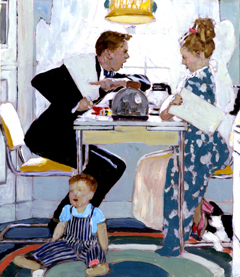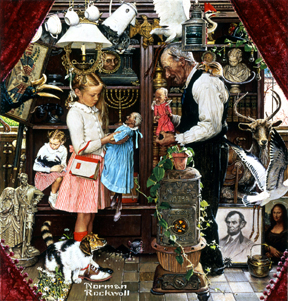An American View: Art on Long Island
By GINGER LEE HENDLER
ART TIMES Nov/ Dec 2009
|
POET, JOURNALIST, ILLUSTRATOR, fine artist: however we choose to define him, Norman Rockwell has most certainly earned a well-deserved place in American culture. A chronicler of Americana since the 1920’s, entering parlors for decades through his Saturday Evening Post covers, he has thoroughly ensconced himself into our heritage. Walking through the galleries at the Nassau County Museum of Art’s current exhibit, it is not unlikely that you may feel nostalgic while viewing his work so carefully hung, paintings juxtaposed with magazine cover and text. Those too young to remember the period itself will undoubtedly see his work as a walkthrough of American history and a look at a cross section of political and social themes. His meticulous journalistic eye created scenes depicting the human condition with all its flavors. In his own words, he said, “I paint life as I would like it to be.”
I was most impressed with the paintings. The first one I saw was “The Rescue” (Through the Storm) done en grisaille, the French term for a painting done in monochromatic tones of black and white. I was taken by the painterly style and freedom of brush. I had been expecting the tight control so clearly associated with Rockwell’s illustrations. Walking through this exhibit I was introduced to another side of Rockwell and I might add that it was quite refreshing to dispel the myth that he was not a fine artist. Indeed, the curators here had a vision when they hung the paintings side by side with the covers, giving the viewers the opportunity to see the evolution of his work.
A showcase in the center of the gallery held several copies of The Saturday Evening Post as well as a color plate from a copy of Tom Sawyer and Huck Finn, which he was commissioned to do. Although much of his work has a guileless innocence, he was not always about sweetness and the glorification of the American people. His depiction of Ruby Bridges in “The Problem We All Live With”, a gouache on paper, dramatizes that not so small moment when a young black girl, Ruby Bridges, was escorted to school by government officials in 1964.
 Norman Rockwell (1894-1978) Breakfast Table Political Argument (oil study) 1948, oil on acetate on board Saturday Evening Post cover oil study, October 30, 1948 (Photos courtesy Archives of American Illustrators Gallery™ NYC) |
As a true storyteller, Rockwell brings humor to his studies as well as a twist of irony, giving depth and expressiveness to the characters and their plight. In “The Waiting Room”, I was drawn in by the ashtray set on the table with cigarette butts overflowing. The expressions of anxiety on each waiting patient capture the essence of the situation, but the details are a testament to Rockwell’s sensibilities and his observations of human behavior.
There are only 48 paintings compared to approximately 300 Saturday Evening Post covers, which adorn the walls of all the galleries upstairs and several on the main floor. Posters of the “Four Freedoms” are displayed along with “Buy War Bonds” posters. I tried to glance at each of the cover illustrations. They were fascinating to look at, but too many to really care enough about each one. I understand that it must have been a coup to have amassed the covers for the exhibit; however more than one trip might be necessary for a better look.
After viewing the exhibit I can see that Norman Rockwell has captured the essence of the human drama, the foibles, and the characters, and he has given the world a bird’s eye view with a socio/political slant. I once heard a professor make some rather scathing and condescending remark to a much younger fellow student, who thought of Norman Rockwell as a great American artist. I think this is an important show, if only to see the breadth of his work and the amazing eye that this “artist” had for the meticulous. Absorb what you can, but never throw the baby out with the bathwater.
*“Norman Rockwell: American Imagist” (September 20, 2009 through January 3, 2010) Nassau County Museum of Art, One Museum Drive, Roslyn Harbor, NY (516)484-9337, nassaumuseum.com
 Jane Freilicher (American, b. 1924) Grey Day, 1963 Oil on canvas (Photo Courtesy Parrish Art Museum) |
“American Landscapes: Treasures from the Parrish Art Museum” is a lovely show. It is the story of landscape painting from the mid-eighteenth century to the present and the American painters who pass on that tradition. The fifty one paintings included in the exhibit span the influx of industrialization, impressionism, and the impact of modern thinking on the painter’s vision. Artists traveled to Europe and returned home with changed palettes and awareness. The light on the mountains, the strength of the ocean’s waves, and the delicacy of the lines became transformed as the artist became more infused with the tone and mood, freeing themselves from the strict rules of an earlier time. Theodore Robinson’s painting, “Moonlight, Giverny,” ca. 1892, reflects impressionist techniques, yet doesn’t abandon the structure, form and integrity of his academic training. William Merritt Chase’s oil on wood panel, “Park in Brooklyn”, is an homage to French Impressionism.
The exhibit takes us on a virtual geographical tour, throughout the Hudson River Valley, the Adirondacks, and Niagara. It travels across the Atlantic to Giverny, Provence and Anacapri, but mostly it is a panoramic perspective of the great American landscape. “Horseshoe Falls, Niagara”, an oil on canvas, is a very powerful painting by John Henry Twachtman. At first I was sure I didn’t care for the painting, but then I found myself somewhat engaged in its terrific movement and kept going back to it, almost as though it became a pivotal experience. I felt the same thing with the April Gornik in the last gallery. Her work is immense in scope and the gallery’s space is a perfect home for it. There are three rocks emerging mysteriously from a body of water. Their reflections cast a shadow, but the eye wants to turn that into a continuation of some organic shape. It doesn’t matter what it is or even that it is a landscape. One can immerse the human figure into the painting or simply eliminate the connection altogether. There is an illusory existential feel to the work.
 Frederick Childe Hassam (American, 1859–1935) Church at Old Lyme, 1906 Oil on canvas (Photo Courtesy Parrish Art Museum)) |
The first gallery appeared dark and foreboding, even with the whiteness of the walls and the light. Similar to watching a 1930’s film noire, where I have to realign my sensibilities to an earlier style, place, and time, I felt the paintings were stilted and reserved. Moving into the second gallery, there was a clear evolution from formality and a greater freedom from linear structure began showing up more often on the canvases. The traditional American postcard was so beautifully evident in the painting by Frederick Childe Hassam, “Church at Old Lyme”. The white church and its ascending steeple stretching up to blue sky and disappearing into white clouds, recreates a familiar scene of small town life. A watercolor on paper, by James Abbott Mc Neill Whistler, “Blue and Silver”, is a small gem of a painting. Its simplicity of line and color is a vast contrast to Gornik’s work, but the statement is pure and gentle. An oil on masonite by Anna Mary Robertson (Grandma Moses) has her signature primitive gestures, most typical of naïve folk art. Once again there is the church, a winding country road, hills dotted with houses, farms, and several figures on horseback in the foreground.
The last gallery is open and light with high ceilings. This openness is a perfect space to house the larger canvases and more contemporary work. There is an uncluttered feeling, which complements the color that peeks through in much of the work. On one wall I was aware of the continual peek-a-boo of color, mostly warm reds and oranges weaving through the paintings. In “Backyard Southampton”, by Fairfield Porter there is a small burst of orange behind one of the houses, which sets off the deep green of the foreground. The tree to the right has lost its leaves and is a portent of the barren winter to come. A sliver of pink snakes across Jane Freilicher’s oil on canvas, “Grey Day”. A gift from the collection of Larry Rivers, there is a looseness about her work that is evident in the dripping paint. And John Marin’s colorful abstracts are filled with spirited energy and painterly brush strokes.
 John Marin (American, 1870–1953) Tunk Mountains, Maine, 1946 Oil on canvas (Photo Courtesy Parrish Art Museum) |
All in all this is a fine show with an extensive range of work done by an array of masters of landscape. As these paintings are only occasionally shown, it would be a worthwhile trip to see the exhibit and perhaps tour the East End of Long Island, a subject for many of these paintings. “American Landscapes” is one of three exhibitions from the Parrish that will be on circulation to other museums. *“American Landscapes: Treasures of the Parrish Art Museum” September 27 through November 29, 2009, 25 Jobs Lane, Southampton, NY 11968 (631) 283-2118, parrishart.org
A Look Ahead:
“Long Island Moderns: Artists on the North Shore from Edward Steichen to Cindy Sherman” October 3, 2009 - January 10, 2010
This exhibition celebrates the rich, yet often overlooked, role of Huntington and the North Shore of Long Island in Aerican art. For more than a century, Long Island has attracted and inspired innovative artists of the highest caliber who have created groundbreaking works of enduring importance. While the art produced on Long Island’s East End has been well documented, the artistic history of Huntington and the North Shore are understood only piecemeal despite the fact that significant artists have worked here. Long Island Moderns will showcase approximately 60 paintings, sculptures, photographs, and drawings. Heckscher Museum of Art 2 Prime Avenue, Huntington, NY 11743-7702 (631) 351 3250 heckscher.org
“Under the Canopy of Heaven”: Works by William Sidney Mount (through June, 2010)
The Long Island Museum, 1200 Route 25 A, Stony Brook, NY 11790 (631) 751-0066 longislandmuseum.org

